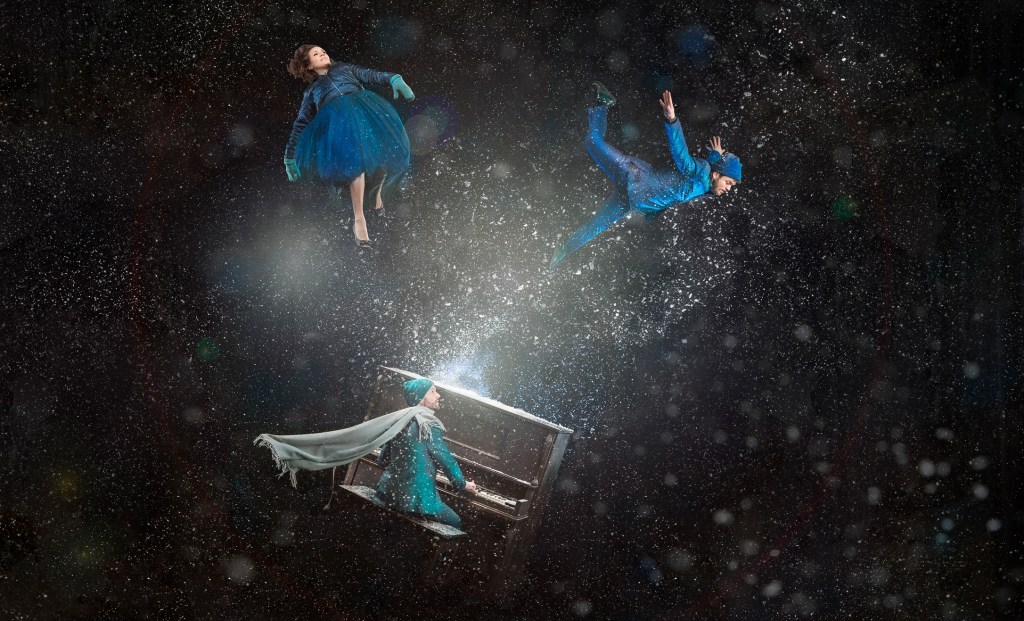The world of tamed tigers and tightwire artists has long captured the public’s fascination, transforming risk into a celebration of the fantastical for audiences young and old. Unlike the gilded institutions that pandered to the sensibilities of well-appointed patrons, the circus welcomed everyone. In the 1800s, artists such as Georges Seurat and Henri de Toulouse-Lautrec would dedicate their canvases to the subject of acrobats and embellished entertainers, elevating the humble circus into the realm of high art.
By the 20th century, the genre had begun to inform new expressions of movement, from 1920s French actor Étienne Decroux’s corporeal mime style to Bay Area modern dancer Terry Sendgraff’s exploration of aerial dance in the 1970s and the physical theater prowess of Charlie Chaplin’s grandchildren Aurélia and James Thierrée in the late ’90s, sliding out from under the big top and onto the formal stage. The circus as we once knew it may have all but disappeared, but its spirit had endured.
Not to be outdone by Europe and its neighbors to the south, Canada’s largest province, Quebec, swiftly threw its hat into the ring, launching a government-backed initiative to help support the lagging art form. The result? The 1981 opening of North America’s first and only higher-education circus school, École Nationale de Cirque, and a $1 million grant to a then-modest little outfit called Cirque du Soleil.
Their efforts paid off, and today, Quebec reigns supreme in all things big top, leading the charge with more than a dozen professional companies from Montreal to Quebec City. Cirque du Soleil currently generates an annual revenue of over $1 billion, employing more than 4,000 people across the globe. In Canada, a young trapeze artist is equally revered among the country’s ballet dancers and classical musicians, with subsidies and grants correspondingly allocated between the varying disciplines. What was once commonly known as “nouveau cirque” is now simply referred to as contemporary circus, a style that emphasizes the genre’s theatrical, dance, and musical components while holding fast to its awe-inducing roots. And Quebec, it would seem, knows how to execute contemporary circus with distinguishing flair.
The programmers at UCSB Arts & Lectures have long recognized the singular appeal of Quebecois circus, exposing Santa Barbara audiences to companies such as Les Sept Doigts de la Main and Cirque Éloize over the last several seasons. This year, they’ve doubled down with two companies in February, giving audiences a rare opportunity to experience the breadth of this innovative region and its undeniably talented artists.
First up is Flip Fabrique, a newer company straight out of Quebec City known for its daredevil tactics and playful spirit. On Sunday, February 9, The Granada Theatre stage will be playing host to their latest eight-member production, Blizzard: a theatrical symphony of jugglers, aerialists, and acrobats set against a bare, wintry landscape that includes an original score by circus darling Ben Nesrallah. Aerial straps, cradle, and hand-to-hand partnering are among the featured disciplines, with plenty of banquine (ensemble acrobatics) in between.
On Tuesday, February 18, Montreal-based troupe Cirque Éloize returns to Santa Barbara with Hotel, an art deco-inspired spectacle to celebrate their 25th season. Eleven artists take refuge in a grand hotel, where secrets and sentiments are revealed through the kinetic rigor of aerial feats, acrobatic dancing, and a jazz-infused soundtrack. Highlights will include Chinese Pole, aerial contortion, and live singing by the haunting pipes of Eléonore Lagacé.
If a trip to the circus still invokes memories of stale popcorn and geriatric lion tamers, then step right up and into The Granada Theater next week. These wholly original, gravity-defying companies might just inspire you to run away and … well, you know. And sequins, I’m happy to report, are completely optional these days.
4•1•1 | UCSB Arts & Lectures presents Quebec City’s Flip Fabrique on Sunday, February 9, and Montreal’s Cirque Éloize on Tuesday, February 18. Both shows take place at The Granada Theater (1214 State St.). See artsandlectures.ucsb.edu.

